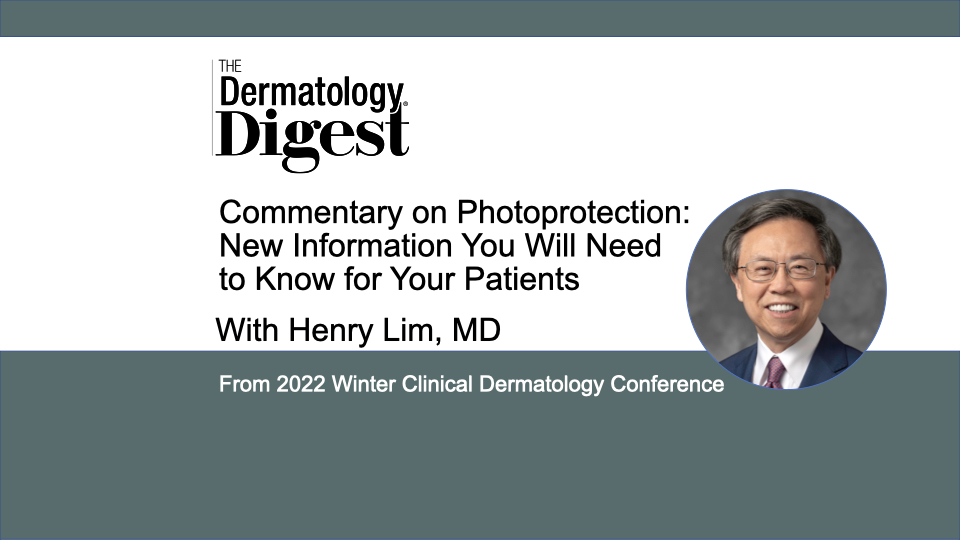Dr. Henry Lim discusses important new developments in photoprotection, from zinc oxide safety to visible light protection, and more.
“I covered several topics, one of them being the potential toxicity of zinc oxide that was recently published,”1 said Henry W. Lim, MD, who presented “Photoprotection: New Information You Will Need to Know for Your Patients,” at the 2022 Winter Clinical Dermatology Conference.
“I emphasize that the finding is irrelevant to the sunscreens that are marketed in the U.S. and all over the world. This is mainly because that particular study was done using an uncoated form of zinc oxide. We do know that for marketed sunscreens all over the world, the zinc oxide is coated. Therefore, the free radicals that can be generated upon exposure of zinc oxide to sunlight are completely contained within the coated particle and…would not cause any damage on the skin.”
As a result, if a patient asks about the safety of zinc oxide in sunscreens, dermatologists can tell them the study’s findings are irrelevant to the products they use for photoprotection, according to Dr. Lim.
Sunscreens and Bone Health
“There was a great study that was just published looking at over 3400 individuals in terms of bone health and their practice of photoprotection. The bottom line is that regular practice of photoprotection, including the use of sunscreen…would not result in decreased bone mineral density,” said Dr. Lim.2
“Clearly for patients who practice very rigorous photoprotection—for example, patients with severe photosensitivity—our recommendation would be to give them oral supplements of vitamin D just to make sure they continue to have vitamin D sufficiency.”
Visible Light Protection
“In the past few years, there have been a lot of studies, including by our group, looking at the effect of visible light on the skin. What has been demonstrated is that visible light would induce intense and persistent pigmentation in dark skinned individuals,” Dr. Lim said.
“We now know that reaction is secondary to the action of visible light interacting with opsin-3 receptor on the surface of melanocytes. …currently available UV filter sunscreens are designed to filter ultraviolet light but not filter out visible light. Therefore, it is important to have other filters that can filter out visible light.”
Currently in the U.S. market, tinted sunscreens are the only type of sunscreen that would protect against visible light, according to Dr. Lim.
“The reason being that in tinted sunscreens there are iron oxides, and iron oxide is considered to be an inactive ingredient. …studies have shown that iron oxide-containing sunscreens, do protect against the effects of visible light.”3
In Europe, there are two new filters that are available, which are not yet available in the U.S., according to Dr. Lim.
“One of them would protect against very long wave UVA, so this is between 380 to 400 nm. Up to now there has not been any filter that would protect well into that range of UVA….”
The other is a filter that would protect against visible light, especially the blue spectrum of visible light, which is the shorter wavelength of visible light, according to Dr. Lim.
“Having good filters that would protect against visible light would be very helpful in managing patients with melasma and post-inflammatory hyperpigmentation, conditions that are most prominent in dark skinned individuals,” he said.
The other new development is the use of biologically active antioxidants in available sunscreen products, according to Dr. Lim.
“…we, as well as others, have shown that the presence of antioxidants would help to downregulate the effects of visible light and the effects of UV radiation on pigmentary alteration of the skin.”4
Sunscreens and Hair Loss
Dr. Lim and colleagues have recently reviewed published studies on the association of frontal fibrosing alopecia and the use of sunscreens and facial moisturizers.
“A systematic review has just been completed on data available on this particular topic. Bottom line is that indeed there are associations between the use of sunscreens and the use of facial moisturizers with frontal fibrosing alopecia,” he said.
Those studies were primarily survey studies, however, not studies designed to identify the triggering factor for frontal fibrosing alopecia, said Dr. Lim.
“So, we cannot identify…what UV filter, for example, would trigger frontal fibrosing alopecia. Likewise, it is clear that in studies looking at facial moisturizers that do not contain sunscreen, [their use] also is associated with frontal fibrosing alopecia. So, potentially other factors are triggers of frontal fibrosing alopecia.”5
At this time, what dermatologists can say with confidence is that there is an association between sunscreen use and use of facial moisturizers that do not contain sunscreen with frontal fibrosing alopecia, but there is no cause-and-effect relationship that has been identified, according to Dr. Lim.
Disclosures:
Dr Lim has served as investigator (grant to institution) for: Incyte, L’Oréal, Pfizer, and Patient-Centered Outcomes Research Institute; consultant for Pierre Fabre, ISDIN, Ferndale, La Roche-Posay, and Beiersdorf Inc; and as a speaker in a general education session for La Roche-Posay and Cantabria Labs.
References:
- Aurora L. Ginzburg, Richard S. Blackburn, Claudia Santillan, Lisa Truong, et al. Zinc oxide-induced changes to sunscreen ingredient efficacy and toxicity under UV irradiation. Photochemical & Photobiological Sciences, 2021; 20 (10): 1273 DOI: 10.1007/s43630-021-00101-2
- Afarideh M, Sartori-Valinotti JC, Tollefson MM. Association of Sun-Protective Behaviors With Bone Mineral Density and Osteoporotic Bone Fractures in US Adults. JAMA Dermatol. 2021;157(12):1437-1446. doi:10.1001/jamadermatol.2021.4143
- Lyons AB, Trullas C, Kohli I, Hamzavi IH, Lim HW. Photoprotection beyond ultraviolet radiation: A review of tinted sunscreens. J Am Acad Dermatol. 2021;84(5):1393-1397. doi:10.1016/j.jaad.2020.04.079
- Lim HW, Kohli I, Ruvolo E, Kolbe L, Hamzavi IH. Impact of visible light on skin health: The role of antioxidants and free radical quenchers in skin protection. J Am Acad Dermatol. 2022;86(3S):S27-S37. doi:10.1016/j.jaad.2021.12.024
- Maghfour J, Ceresnie M, Olson J, Lim HW. The Association between Frontal Fibrosing Alopecia, Sunscreen, and Moisturizers: A Systematic Review with a Meta-Analysis [published online ahead of print, 2022 Jan 21]. J Am Acad Dermatol. 2022;S0190-9622(22)00083-4. doi:10.1016/j.jaad.2021.12.058


